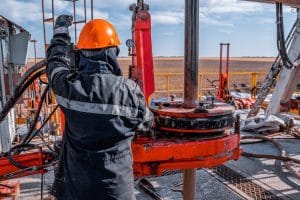The Dangerous Work of Oilfield Roughnecks and Roustabouts
 The thriving oil and gas industry in North Dakota offers a variety of employment opportunities for men and women throughout the state. With one of the largest oil reserves in the country, our oil workers provide a valuable service, but not without great risk of injury. These workers deserve the highest safety standards on the job, and when preventable accidents cause them harm, they also deserve help recovering from those injuries.
The thriving oil and gas industry in North Dakota offers a variety of employment opportunities for men and women throughout the state. With one of the largest oil reserves in the country, our oil workers provide a valuable service, but not without great risk of injury. These workers deserve the highest safety standards on the job, and when preventable accidents cause them harm, they also deserve help recovering from those injuries.
What does a roustabout do?
According to 2021 research by Chron, nearly 60,000 roustabouts worked in the oil and gas industry in 2019, earning somewhere between $28,000 and $58,000 annually. As part of their training, they must undergo basic first aid and firefighting, so that they are prepared for any emergency.
The primary responsibility of an oilfield roustabout is assembly and repair of the equipment. They may also be tasked with:
- Loading/unloading pipes from trucks.
- Assisting oilfield workers to ensure they have the tools and materials they need.
- Assisting crane operators with transport of loads.
- Dismantling oilfield machinery.
- Using power tools and heavy machinery to complete these tasks and/or any others assigned to them.
- Keeping work areas clean and safe.
Roustabouts have a physically demanding job. They could be standing or moving for hours at a clip. The constant bending, lifting, climbing stairs, etc. can put stress on the body, but they face significant risk of injuries from using heavy machinery and power tools.
What does a roughneck do?
Roughnecks, like roustabouts, also handle maintenance and repair. The difference is that they work directly on the drill and drilling platform themselves. This position is a step higher than a roustabout, and therefore considered more skilled. Roughnecks may also be tasked with filling in for other positions. One former roughneck described his role this way:
I jumped from rig to rig, filling in where a man was needed. If a floorhand was injured or sick, I took his place running the tongs. If the derrickman didn’t show or quit or was let go, I filled in on the floor while someone took his place. If all the rigs were running with four men, a full crew for a pulling-unit, I served as a hot-shotter, a glorified gopher, delivering parts and equipment to rigs anywhere along a two-hundred-mile stretch spanning from Sterling City, Texas, to Hagerman, New Mexico.
Roughnecks also have physically demanding jobs, but their ability multi-task and work in other positions is what sets them apart. They, too, face risk of injury from the machinery and tools they use.
What are typical injuries experienced by roughnecks and roustabouts?
Because roughnecks and roustabouts are manual laborers, they work long hours (often 12-hour shifts or more) with physically demanding tasks. Without proper training, rest, and safety procedures in place, they can suffer accidents and injuries like:
- Explosions and fires, resulting in severe burn injuries.
- Exposure to toxins and chemicals, resulting in respiratory issues and internal burns.
- Caught-in or caught-between machines or moving parts, or entrapment in confined spaces, resulting in crush or amputation injuries.
- Motor vehicle accidents, from traveling back and forth between job sites.
- Falls from heights, causing traumatic brain injuries, spinal cord trauma, and other catastrophic injuries.
- Equipment malfunctions, resulting in a variety of injuries, including amputation injuries, broken and crushed bones, or loss of vision.
- Hearing loss from working around extremely loud equipment for extended periods without a break.
Some injuries and accidents are so severe they can take the life of an oilfield worker, either at the scene or later in the hospital. In cases like these, our attorneys can work with the family on a wrongful death claim against any and all liable parties.
What is the proper safety equipment for oilfield workers?
Oilfield workers must be provided personal protective equipment (PPE) to perform their jobs. When employers fail to do this or fails to train workers on proper safety procedures, and a worker suffers severe or fatal injuries, employers should be held responsible.
Typical PPE for oilfield workers includes:
- Flame-resistant clothing, designed to prevent flames from spreading if exposed to embers or fire.
- Fall protection, as roughnecks and roustabouts often climb elevated equipment. These usually include harnesses and fall arrest systems.
- Hearing protection and safety glasses, to help avoid hearing damage and protect the eyes from flying debris, sun, dirt, and oil.
- Steel-toed boots and hard hats, protecting the head and feet from heavy equipment or falling objects.
- Work gloves and specialty gloves, for tasks like welding, cutting, and handling chemicals or other dangerous substances.
How prevalent are oil and gas industry accidents?
An article from the Center for Public Integrity analyzed several sources of oil and gas industry accident data, as well as spoke to safety experts and accident victims. Among their findings:
- Between 2008 and 2017, 1,566 workers died from extraction industry injuries – nearly the same amount of U.S. troops killed in Afghanistan during the same timeframe.
- Between 2008 and 2018, OSHA handed down 10,873 violations to oil and gas extraction companies, with 64% classified as “serious” – meaning the violations were likely to cause “death or serious physical harm.”
Said David Michaels, head of OSHA at the time, regarding American Petroleum’s assertion of their low injury rate, “They have a low injury rate because they often don’t report their injuries. They have a very high fatality rate, so it’s simply not possible they have a low injury rate.”
What should I do after an oil rig or oilfield accident in North Dakota?
If you sustain a serious injury on the job, ensure you take the following steps to protect your health and any potential legal action:
- Seek immediate medical help for your injuries. Your health and your safety should always be your first priority.
- Report your accident and injury to your supervisor as soon as possible.
- If you can, take photos of the accident site, your injuries, and any other relevant evidence. These can go a long way in proving your case.
- Collect contact information from any witnesses who may have been on the scene to help corroborate what happened.
- Keep copies of all of your medical records and any documents relating to your accident and injuries. Your attorney will need these for your case.
Finally, talk to the Minot personal injury attorneys at Larson Law for knowledgeable guidance on what to do next.
The experienced oil rig accident attorneys at Larson Law represent roughnecks, roustabouts, and other workers hurt in the patch. We understand the severity of these types of accidents and injuries, and want to help you and your family through the legal process. We fight for financial compensation while you take the time you need to recover from your injuries – leave the stress and worry to us. To schedule a free consultation with one of our attorneys, call 701-484-HURT, or complete our contact form. We maintain offices in Minot, Fargo, and Bismarck.

Mark Larson is a Certified Civil Trial Specialist and Certified Civil Pre-Trial Specialist focusing on personal injury, car accidents, wrongful death, and oil field claims. Since 1979, Larson Law has served the injured throughout North Dakota. Read more about Mark V. Larson.
